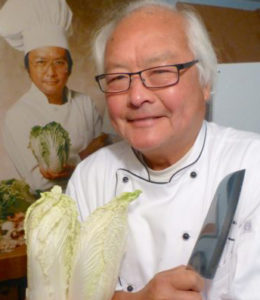Wok & Roll by Peter Kwong, (Frederic) Inter-County Leader
» Download this column as a Word document
Many people I’ve met have never heard of dim sum, not to mention actually trying them. Growing up in Hong Kong, dim sum is popular like the Big Mac, except that there is no Happy Meal version.
In straight translation, dim means touch and sum is your heart. So, a touch of your heart. Can you visualize a certain food that can actually touch your heart? Well, it sure did to me for many, many years.
It was, and still is, a tradition on weekends and holidays; folks will gather with their families and friends in dim sum houses to have some comfort foods and to chat and catch up. It is amazing that at every dim sum house, there will be a long line waiting even though the house is already packed. You take a number, and then you just patiently wait till your number is called. Most restaurants won’t even bother with taking reservations, it’s all first come, first served.

So, what’s the magic about dim sum houses that makes them so intriguing? Let me explain the ritual from the very beginning.
Dim sums are tasty bite-size morsels that are made with shrimp, pork, beef, tofu and whatever the chefs created. They can be steamed, baked, fried, braised, stuffed or sauteed. And there are at least a hundred, if not more, varieties. They are served either in a bamboo steamer or on small plates, like tapas.
The tradition began hundreds of years ago. It is a place to socialize, to do business, and to get some relaxation and great foods. It has become a daily routine called “yum cha,” drink tea. And here is the ritual:
After your number is called, and you get seated, the first thing the server asks will be, “What kind of tea would you prefer?” Most teahouses are stocked with high-quality teas, and they do charge you accordingly. Most of them charge $1 to $2 per person. So, know your tea, and don’t get tea bags!
There are red teas and green teas. Red teas include oolong, pu-erh, Dragon Well and lychee red. These teas are stronger and rich with flavors. And then there are the green teas. Most popular are jasmine flower and chrysanthemum, and a new combination called “goak poh,” which is a combination of pu-erh and chrysanthemum.
Anyway, do not pour the tea right away, let it brew three to five minutes. That’s the fun of yum cha, you take your time in enjoying everything. No more eat and run, or eat while you run. Now is the time to enjoy every moment.
Soon you will notice cart after cart of foods passing you by. Those carts are equipped with steamers at the bottom, so whatever foods they are carrying are guaranteed to be piping hot when they reach your table. However, those carts will not stop at your table unless you wave them down. So, you have to start learning what you would like to order. Actually, most of the dishes are very popular in the U.S., except these few:
- Chicken feet – you have to develop a taste for it. It is the same watching someone munching on pig’s feet the first time.
- Beef tripe – once you try them, you’ll love them, but …
- Baby octopus – especially in curry sauce. But it is hard to eat anything with tentacles still attached.
So, here are my 10 favorites, you can’t go wrong with them. And even if it’s your first time, just ask your server to get them for you, they’ll be most happy to oblige:
- Har gow – rice wrapper stuffed with shrimp and bamboo shoots. Steamed.
- Siu mai – dumpling filled with minced pork and shiitake mushroom. Steamed.
- Egg roll – light and crispy. One is filled with shredded vegetables and the other with shrimp. Deep fried.
- Char siu bao – buns stuffed with tasty barbecued pork. Steamed or baked.
- Nin yung bao – buns stuffed with mashed sweet lotus seed. Steamed.
- Wu kok – taro roots mixed with seasoned pork, dipped in a batter then deep fried.
- Cheung Fun – steamed rice noodles filled with either shrimp, beef or barbecued pork. The sweet soya sauce to pour over enhances the flavors.
- Lo bak go – made with daikon radish. Comes lightly pan fried. A lot of work goes in the making. Your first bite will tell you.
- Potstickers – stuffed with minced pork and dipped in a ginger soya sauce.
- All depends on the chef, I have experienced many dishes that I have never heard of — stuffed eggplant with minced seafood mix, shrimp wrapped with seaweed … so be adventurous.
While you enjoy the food and conversations, observe these few simple rules:
- When your teapot is empty, just move the lid to the side. No need to try to get your server’s attention. I’ll explain why later.
- When someone pours tea for you, respond with tapping the table with your second and third fingers. They represent your head, and you’re bowing back to say thanks.
And oh, one more thing — your table receives a ticket when you’re seated. The ticket has the prices for each dish. The server will circle the dish when it is delivered to you. When you’re done eating, they simply add up the prices of the dishes you ordered and you pay the cashier. Easy and simple.
Now you have it, enjoy. The sad thing is that there are not too many dim sum houses here in northern Wisconsin, so we have to travel west to Minnesota. But the trip is well worth it.
Go to phkwong.com for more columns and to purchase his book, “Wok & Roll.”



